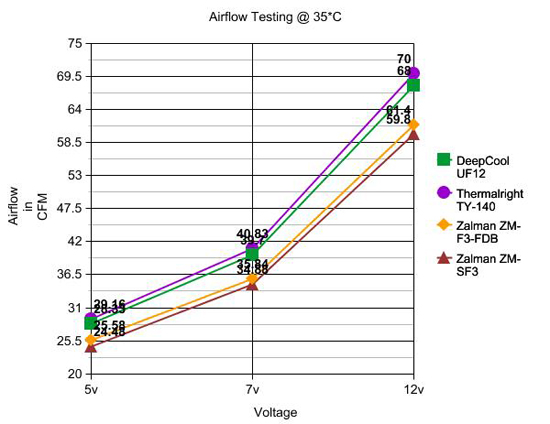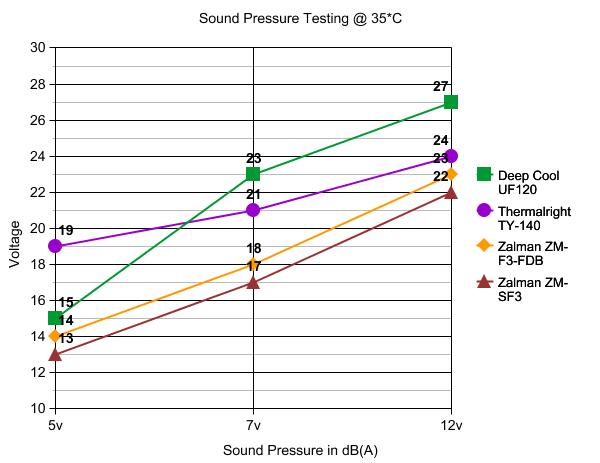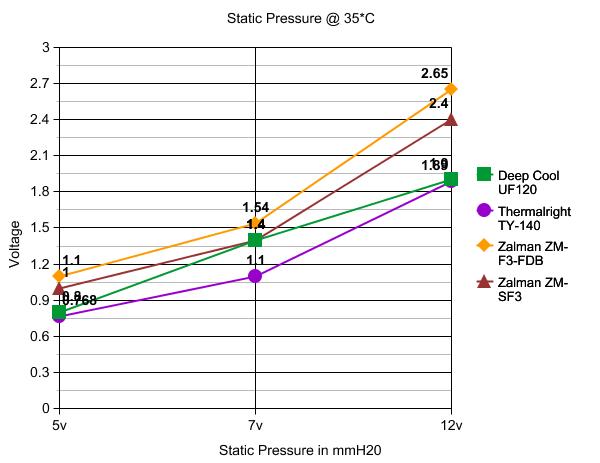Zalman ZM-F3-FDB & ZM-SF3 120mm Cooling Fan Review
Testing the Zalman Fans

Today we’ll be testing 4 Aspects of these fans:
- Sound Pressure Level (recorded in dBA)
- Airflow (recorded in CFM)
- Static Pressure (recorded in mmH20)
- Heat Tolerance (testing done at 30*C)
The Testing Equipment that I will be using was purchased by me and it includes:
- Dwyer Differential Pressure Gauge Model 2000-00 AV
- General Tools DCFM8906 Digital Air Flow Meter
- Tenma Digital Sound Level Meter
- Kintrex IRT0421 Non-Contact Infrared Thermometer
- Universal Enterprises DM383B Digital Multimeter
Today we will be testing these fans against some other fans of my collection to give a comparison against fans offered by the competition.

These are all fans like the Zalman which advertise as being silent solutions with the same 20-25dB(A) range of sound pressure. From left to right: Deep Cool UF120 (reviewed here before), Thermalright TY-140 (uses 120mm fan mounting), Zalman ZM-F3-FDB, Zalman ZM-SF3.
Now onto testing. 
Well, here is an interesting point to add, I really have no baseline to go with as Zalman does not list CFM ratings. I also realize that it’s hard to tell what numbers are what on this graph because of the over-lap from the fans so I will add a chart for you to read, as well.
| Airflow in CFM | |||
| Fan Model | Airflow @ 5v | Airflow @ 7v | Airflow @ 12v |
| Deep Cool UF120 | 28.33 | 39.7 | 68 |
| Thermalright TY-140 | 29.16 | 40.83 | 70 |
| Zalman ZM-F3-FDB | 25.58 | 35.84 | 61.4 |
| Zalman ZM-SF3 | 24.58 | 34.88 | 59.8 |
Now what can we really obtain for these airflow readings? Well, these fans push less air than the competition by only 10 CFM less. Now, this is not necessarily a bad thing; if the fans are quieter than they are really doing their job.
Let’s see the noise level testing now. 
| Sound Pressure in dB(A) | |||
| Fan Model | dB(A) @ 5v | db(A) @7v | dB(A) @ 12v |
| Deep Cool UF120 | 15 | 23 | 27 |
| Thermalright TY-140 | 19 | 21 | 24 |
| Zalman ZM-F3-FDB | 14 | 18 | 23 |
| Zalman ZM-SF3 | 13 | 17 | 22 |
I always like to give a bit of a subjective input on the sounds of these fans so I’ll give a quick overview between our two test subjects today.
Zalman ZM-F3-FDB
Zalman ZM-SF3

|
Static Pressure in mmH20
|
|||
| Fan Model | Testing @5v | Testing @ 7v | Testing @ 12v |
| Deep Cool UF120 | 0.9 | 1.4 | 1.9 |
| Thermalright TY-140 | 0.769 | 1.1 | 1.89 |
| Zalman ZM-F3-FDB | 1.1 | 1.54 | 2.65 |
| Zalman ZM-SF3 | 1 | 1.4 | 2.4 |
Well, for those of you who do not know what static pressure is or what these numbers mean I’ll break it down pretty easily. Static Pressure is similar to an efficiency rating on how effectively a fan can move air through a restrictive surface like a Hard Drive rack, Fan Grill, Heatsink, or Radiator.
Generally speaking, you wish to see fans in the 2 mmH20 and greater range for heatsink & Radiator use when at full speed. Though normally, “quiet” or “silent” fans lack static pressure because of their blade design and thus are not suited for use on a radiator or heatsink.
Zalman has an impressive showing, though, with a good and quiet fan that can also be adapted for other uses besides a standard case fan. Call me impressed but I definitely was not expecting this when I was giving the visual exam of the fans on the last page.
Let’s wrap this up and we’ll see where everything stands; shall we?

Comments are closed.